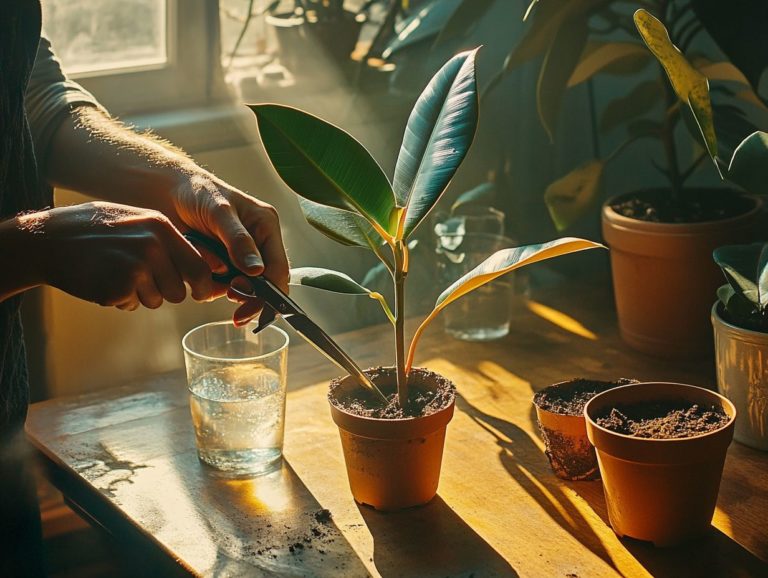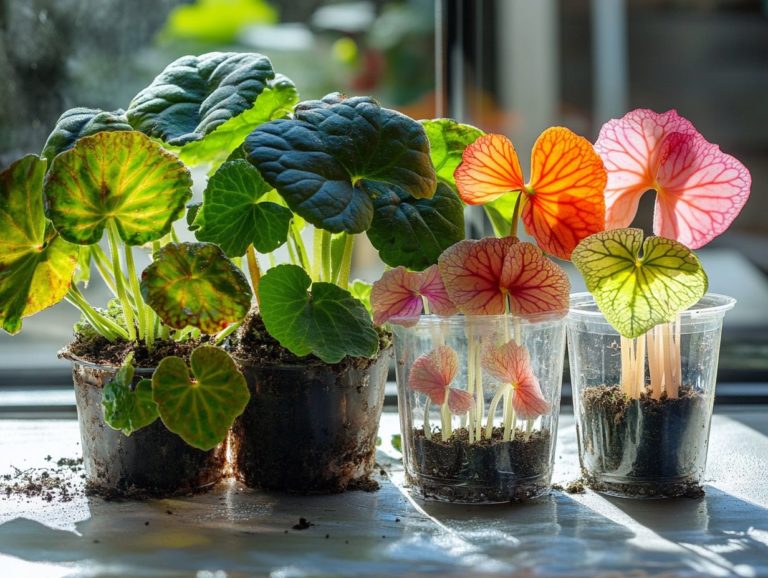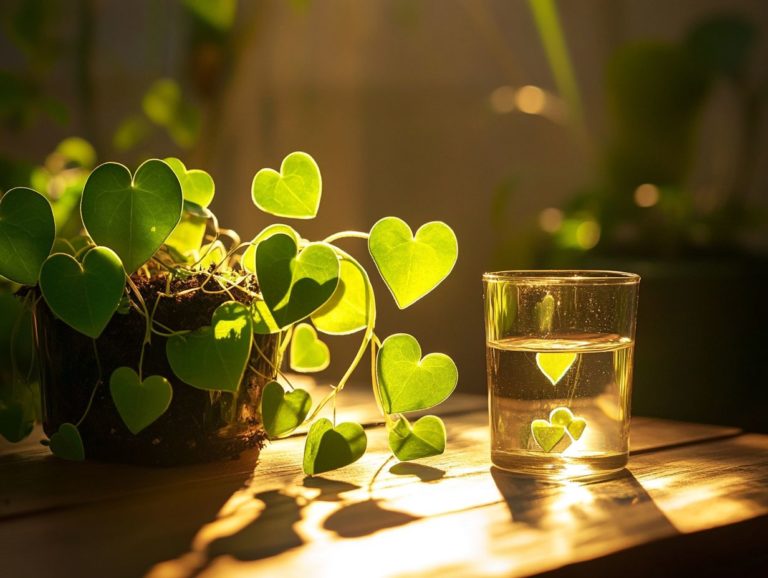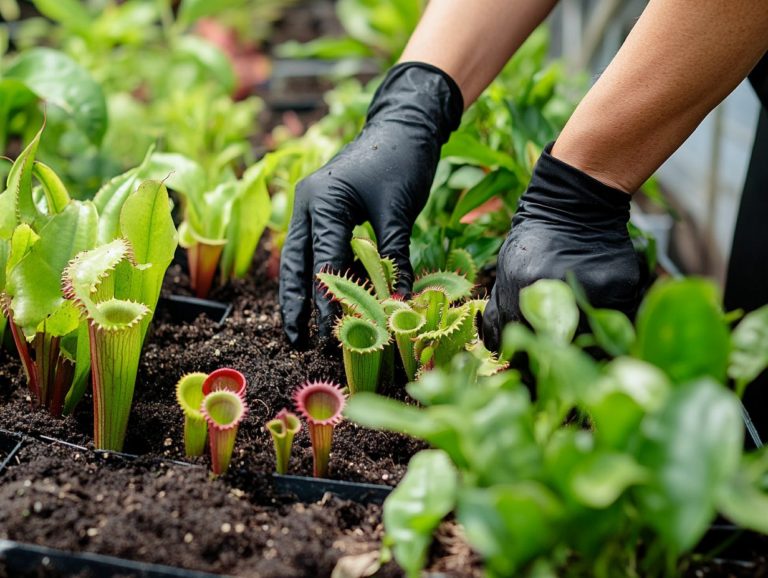How to Propagate Monstera Plants
Monstera plants, with their stunning leaves and unmistakable tropical flair, are a prized choice for indoor gardeners like yourself. Whether you aim to enhance your collection or share the allure of these plants with friends, mastering the art of propagation is essential.
This article delves into various methods for propagating Monstera, including water, soil, and air layering techniques. You ll also find essential tools, a step-by-step guide, and troubleshooting tips for common issues like root rot and pests.
Immerse yourself in this exploration to uncover the secrets behind thriving Monstera propagation!
Contents
- Key Takeaways:
- Methods of Propagating Monstera Plants
- Tools and Materials Needed
- Step-by-Step Guide to Propagating Monstera Plants
- Troubleshooting Common Issues
- Frequently Asked Questions
- What is the best way to propagate my Monstera plant?
- When is the ideal time to propagate a Monstera plant?
- Should I use rooting hormone when propagating my Monstera plant?
- How long does it take for a Monstera cutting to root?
- Can I propagate my Monstera plant in water or does it need soil?
- How many times can I propagate my Monstera plant?
Key Takeaways:

- You can propagate Monstera plants using water, soil, or air layering methods.
- Essential tools and supplies, such as pruning shears and rooting hormone, are needed for successful propagation.
- To successfully propagate a Monstera plant, carefully prepare the plant, choose the right propagation method, and provide proper care for the new plant.
What is Plant Propagation?
Plant propagation is your gateway to creating new plants from existing ones. It holds great value for gardeners and plant lovers, especially for popular tropical varieties like the Monstera Deliciosa, affectionately known as the Swiss Cheese Plant.
This method allows you to expand your indoor jungle while enriching your gardening skills and spreading the joy of nurturing plants.
Mastering propagation techniques is essential for ensuring healthy growth, vibrant foliage, and a robust root system. Whether you choose cuttings, air layering, or other methods, getting involved in plant propagation deepens your connection with nature.
It also supports sustainable gardening practices by reducing reliance on store-bought plants. You can explore various techniques, such as water propagation, where cuttings soak in water until they develop roots, or soil propagation, which involves planting directly in the earth. Each method offers unique benefits tailored to your environment and personal preferences.
When propagating your Monstera, it’s vital to implement the proper care techniques. Maintaining humidity and providing sufficient light can significantly enhance your chances of success. For those interested in learning more about this process, a quick guide to propagating philodendrons can be very helpful. Effective propagation leads to vibrant, healthy plants that elevate any living space while bestowing upon you a satisfying sense of accomplishment.
Methods of Propagating Monstera Plants
When it comes to propagating Monstera plants, you’ll find several effective methods that suit your needs, including water and soil propagation, as well as air layering. Each technique offers distinct advantages and requires particular conditions think humidity, light, and care to ensure successful growth and robust root establishment.
Familiarizing yourself with these propagation methods not only enhances your indoor plant collection but also contributes to the overall health and visual appeal of your Monstera.
Water Propagation
Water propagation is an excellent and beginner-friendly way for you to propagate Monstera plants. Simply place cuttings in a clear container filled with water and watch as those roots begin to grow!
This method is exciting because you can see the roots grow! You’ll need to pay attention to factors like moisture levels and light conditions to promote robust root growth.
When selecting your cuttings, choose healthy stems with at least one node, which is the small bump on stems where leaves grow; this is where roots will sprout. Opt for a clean container to help prevent bacterial growth, creating a healthier environment for your plants.
Ideally, position the cuttings in a place with bright, indirect light to encourage growth without the risk of scorching. Don’t forget to change the water every few days! This simple task not only keeps the roots well-oxygenated but also prevents stagnation, setting the stage for successful root development in a timely manner.
Soil Propagation
Soil propagation is an effective technique for your Monstera plants. This method allows you to place cuttings directly into a well-draining potting mix. Doing so lets the roots establish themselves in a nutrient-rich environment, supporting vigorous growth and mimicking the plant’s natural habitat. As a result, you’ll notice healthier and more resilient foliage.
To achieve successful propagation, ensure proper maintenance, including regular watering and adequate light exposure.
To kick off the process, select healthy cuttings with at least one node. A node is the part of the plant that can grow roots. This encourages optimal growth. A potting mix composed of peat, perlite, and orchid bark will provide the necessary drainage and aeration for root development.
Once your cuttings are nestled in the mix, keep the soil slightly damp. Be careful to avoid overwatering to prevent rot.
Position the cuttings in a spot with indirect sunlight to improve their growth. Don’t forget that occasional fertilization can further boost your Monstera’s health during this crucial early stage.
Air Layering

Air layering is an elegant propagation technique that allows you to root a Monstera cutting while it remains attached to the parent plant. This method fosters a more robust root system. To master this technique, make a cut near a node and cover it with sphagnum moss. This ensures that it maintains adequate humidity for optimal root development.
By opting for air layering, you can enjoy successful propagation with minimal stress on the cutting. The tools required for this process are minimal yet essential: you ll need a sharp, sterile knife, sphagnum moss, plastic wrap, and some string or tape to secure everything in place.
Start by selecting a healthy stem that features a node, as this is where new roots will emerge. Carefully make a shallow cut in the stem, being cautious not to sever it completely. Next, pack the exposed area with damp sphagnum moss and wrap it with plastic. To learn more about this process, check out our guide on how to propagate peperomia plants. Seal it tightly to retain moisture.
Keeping high humidity around the cutting is key to helping your Monstera thrive. This technique not only enhances the chances of successful propagation but can also lead to a stronger, more resilient plant.
Tools and Materials Needed
To successfully propagate Monstera plants, it’s crucial to have the right tools and materials on hand. This paves the way for a seamless and effective process.
Key supplies you ll need include:
- Sharp pruning shears for precise cuttings,
- A clear container for water propagation,
- Well-draining potting mix for soil propagation,
- Sterile rooting hormone to stimulate robust root growth.
By assembling these essential items, you create the ideal environment for a successful propagation experience.
Essential Supplies for Successful Propagation
Essential supplies for your Monstera propagation include a sterile clear container for water propagation, quality potting mix for soil propagation, and rooting hormone to enhance root development. These items work together to create an optimal environment for your plant cuttings, ensuring they thrive and develop into healthy, vibrant specimens.
The sterile clear container is your ally, allowing light to reach the cuttings while preventing bacterial growth. This helps keep the water clean, encouraging robust root formation.
Quality potting mix, rich in organic matter, provides the essential nutrients and drainage necessary for soil propagation. This allows the cutting to acclimatize and establish itself effectively in its new environment.
Incorporating a rooting hormone can significantly boost root growth. This makes it easier for the cutting to absorb nutrients and moisture, ultimately leading to a more robust Monstera. Each element plays a vital role in this delicate process, and their synergy is essential for achieving thriving plants.
In conclusion, mastering proper propagation techniques for your Monstera plants ensures they grow healthy and vibrant. Enjoy the process and the rewards it brings!
Step-by-Step Guide to Propagating Monstera Plants
A step-by-step guide to propagating Monstera plants is essential for both novice and seasoned gardeners who wish to cultivate and maintain their cherished indoor greenery.
The journey begins with selecting healthy cuttings that feature nodes, which are small bumps on the stem that can grow new roots or leaves. This decision leads to the next crucial choice: selecting the right propagation method whether that s water, soil, or air layering.
Each phase demands your keen attention, as best care, humidity, and light conditions are vital for fostering vibrant foliage and strong roots.
Preparing the Plant
Preparing your Monstera for propagation starts with selecting the ideal cutting. Ensure it includes at least one healthy node, as this is crucial for optimal root development. With sharp pruning shears in hand, cut the stem at a 45-degree angle to promote better water absorption and minimize stress on the plant. This careful preparation is key to achieving successful propagation, allowing your cutting to thrive in its new environment.
Understanding the importance of node selection cannot be overstated; these small bumps are future growth points for both roots and leaves. By making precise cuts with sharp tools, you can reduce the risk of damage and boost the likelihood of robust growth. It’s essential to ensure that your cutting has sufficient healthy tissue, as this not only aids in successful propagation but also enhances overall Monstera care as the new plant establishes itself. For detailed instructions, check out our guide on how to propagate your favorite houseplants.
Employing a well-thought-out technique, along with high-quality materials like clean water or potting soil, lays a solid foundation for strong, flourishing growth in the long run.
Choosing the Right Method

Choosing the right method for propagating your Monstera plants is essential and hinges on your gardening style, available resources, and the outcomes you desire. Are you a beginner? Water propagation lets you see roots grow! Or maybe you want a stable environment? Soil propagation is for you! Meanwhile, if you prefer efficiency, air layering provides rapid rooting while keeping the healthy mother plant intact.
Each technique offers distinct advantages that promote healthy roots and vibrant growth. By carefully evaluating these methods against your specific needs, you can make an informed decision that aligns with your gardening goals, ensuring your Monstera flourishes beautifully! If you’re also interested in expanding your plant collection, check out how to propagate rubber plants.
Caring for the New Plant
Caring for your newly propagated Monstera plants is essential to help them establish healthy roots and vibrant foliage. This requires your attention to key factors such as humidity, light, and maintenance. By creating an optimal environment think warm and humid you can significantly enhance their growth potential and resilience during this crucial early stage. By closely monitoring your new plant’s needs, you re setting the stage for a thriving indoor jungle.
To achieve this, establish a consistent watering schedule that keeps the soil lightly moist but not soggy. Insufficient moisture can stunt root development, while overwatering may lead to rot. Positioning your Monstera in bright, indirect light allows it to soak up energy without the risk of leaf burn. Maintaining humidity levels between 60% and 80% will further promote healthy growth, so consider misting or using a humidity tray during the drier months. If you’re interested in propagating your plants, check out how to propagate ZZ plants for additional tips.
By keeping a close eye on these environmental factors, you ensure robust health and longevity for these stunning additions to your home!
Troubleshooting Common Issues
Troubleshooting common issues in Monstera propagation is essential for ensuring the success and vitality of your new plants. Challenges like root rot, pests, and diseases can significantly impede their growth and development.
By understanding these potential setbacks, you can take timely action. This may involve fine-tuning your watering habits, ensuring adequate humidity, or implementing effective pest control measures. Addressing these concerns promptly will set the stage for vibrant, thriving plants that elevate your indoor atmosphere.
Dealing with Root Rot
Don t let root rot ruin your Monstera! Act fast to save your plant. This issue often stems from overwatering or insufficient drainage. It demands your immediate attention if you wish to salvage your beloved greenery.
Recognizing the signs of root rot is crucial. Look out for yellowing leaves, wilting, and a bad odor from the soil. Regularly inspecting the roots during your maintenance routines, especially after heavy watering, will help you catch any issues early on.
Ensuring that your potting mix drains well is vital. Opting for pots with drainage holes will further protect against excess moisture.
If root rot does make an unwelcome appearance, acting swiftly is essential. You’ll need to trim away the damaged roots and transfer your plant to a new, sterilized environment. This decisive action will set your Monstera on the road to recovery, promoting healthy growth and enabling effective propagation practices.
Addressing Pests and Diseases
Addressing pests and diseases is essential for maintaining the health of your Monstera plants. Infestations can swiftly lead to stunted growth and compromised foliage. You ll commonly encounter pests like spider mites and aphids, while diseases often stem from environmental stressors or inadequate care practices.
By implementing simple pest control methods such as regular monitoring and the use of organic treatments you can significantly boost the resilience of your plants.
If you notice tiny webbing on the leaves, it s likely spider mites at work. Aphids, on the other hand, leave behind a sticky substance known as honeydew, which attracts even more pests. Regularly inspecting the undersides of leaves and maintaining optimal humidity levels can help you sidestep these issues.
Yellowing or browning leaves may signal diseases like root rot or leaf spot, typically caused by overwatering or poor drainage. Effective treatments include:
- Keep your soil just right to avoid excess water
- Use neem oil to tackle pests
- Practice crop rotation to reduce disease recurrence
Such proactive maintenance not only protects against infestations but also fosters thriving, vibrant Monsteras in your indoor oasis.
Frequently Asked Questions
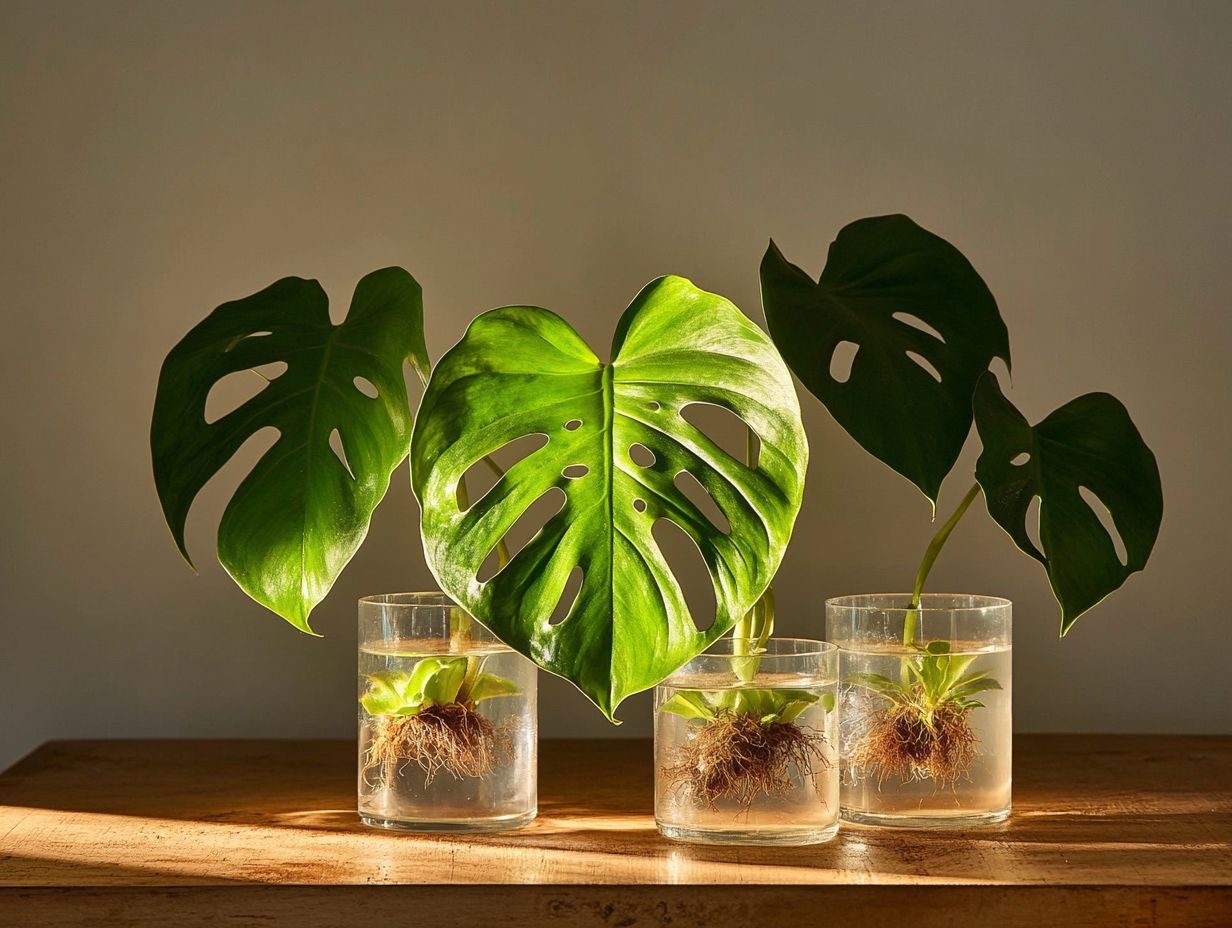
What is the best way to propagate my Monstera plant?
The best way to propagate a Monstera plant is through stem cuttings. Select a healthy stem with at least 2-3 nodes and cut just below a node. Place the cutting in a jar of water or directly into moist soil to root.
When is the ideal time to propagate a Monstera plant?
The ideal time to propagate a Monstera plant is during the spring or summer months when the plant is actively growing. This will give the cutting the best chance to successfully root and grow.
Should I use rooting hormone when propagating my Monstera plant?
While it is not necessary, using rooting hormone can help speed up the rooting process for Monstera cuttings. It contains growth hormones that encourage root growth and can increase the success rate of propagation.
How long does it take for a Monstera cutting to root?
The time it takes for a Monstera cutting to root can vary, but it typically takes between 2-3 weeks. This may be longer if the plant is in a cooler or drier environment. Patience is key when propagating plants!
Can I propagate my Monstera plant in water or does it need soil?
You can successfully propagate a Monstera plant in either water or soil. However, keeping the cutting in water for too long can cause it to become waterlogged and rot. It s important to transfer it to soil once roots have formed.
Start propagating your Monstera today and enjoy the beauty it brings to your home!
How many times can I propagate my Monstera plant?
You can propagate a Monstera plant multiple times if there are healthy stems with nodes to cut from. A node is a small bump on the stem where leaves can sprout.
Be careful not to take too many cuttings from one plant; doing so can weaken it and affect its overall growth. Propagating your Monstera can be a fun and rewarding experience!

